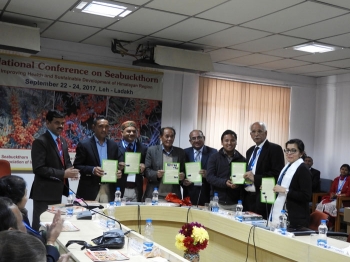3-day national conference on importance of sea buckthorn held in Leh As much as 67% of the berry collectors happen to be women
By Rinchen Angmo Chumikchan
LEH,
Oct 03, 2017

LEH :
A three-day national conference on sea buckthorn with the theme ‘Improving Health and Sustainable Development of Himalayan Region’ was organised by the Defence Institute of High Altitude Research (DIHAR, Leh.
The conference was inaugurated by Tsering Wangdus, EC, Agriculture, and was attended by more than 100 delegates from various research and development organisations. An abstract book and other publications were also released by Wangdus.
Dr. S.K Dwivedi, DIBER, Haldwani, was awarded National Award for his outstanding resource contribution in sea buckthorn.
According to an estimate, 2500 hectares of barren land can be brought under sea buckthorn plantation without much investment in Leh District. If cultivation is done on 2500 hectares in a planned manner, the projected net income from Sea buckthorn alone is estimated to be Rs 491 cr per annum. Income generation will increase manifold if the value-added products are also manufactured in the region.
Dr. O.P Chaurasia, Director, DIHAR, briefed about the aims and orientation of the conference and said that the value of sea buckthorn was better than that of Amla.
“In the early 90s, the farmers approached DIHAR regarding the sea buckthorn. Since then we started working on this plant”, said Chaurasia. He also informed that the first article was published in Tribune in the year 1994.\
He said that sea buckthorn is an ecologically and economically important plant of the Trans- Himalaya region and “today with the efforts of the DRDO, Hill Council and Forest Department we know the value of sea buckthorn. Today farmers harvest 500 tons of sea buckthorn.”
Nawang Rigzin Jora, MLA, said, “Unfortunately, we realised the importance of sea buckthorn very late, but Amchis knew the value of sea buckthorn as early as the 7th century. And in Sowa Rigpa, there are 100 formulations based on sea buckthorn.”
“In India, of the total area which is under cultivation, Ladakh has 70% of it. As of now, we have only been able to harvest 5% of the total produce available here. We have the potential to bring in another 2500 hectares under cultivation. And if we are able to do that, it will generate 490 crore income from sea buckthorn,” said Jora.
Tsering Wangdus said if we go for large-scale sea buckthorn plantation on 2500 hectares, the income from collecting the berry is going to be 250 cr every year. This is a huge amount as compared to our district budget of ₹ 80- 100 cr per annum.
“We have approximately 10,000 hectares under natural sea buckthorn plantation which is approximately 71% of the total area under sea buckthorn in the entire country. We are harvesting 400-500 metric ton of sea buckthorn every year, resulting in an income generation of ₹ 3cr. Considering the small population of around 1.5 lakh in the district, generating an additional income of ₹ 3 cr through sea buckthorn raw materials means a lot. More importantly, the beneficiaries are the needy section of the society, particularly the women. 67% of the berry collectors are women and this helps in women empowerment in Ladakh region,” said Wangdus.
He said that there should be more research and invited the scientific community to come forward in making sea buckthorn plantation a reality. Certain formulations need to be formulated, he added.
Dr. Brahma Singh, Padmashree, and ex-director, Life Science, DRDO, presented the keynote lecture. He said that sea buckthorn has many uses and the vast barren land in the region can be brought under sea buckthorn plantation.
Dr. Stobdan, DIHAR scientist, presented the vote of thanks.





